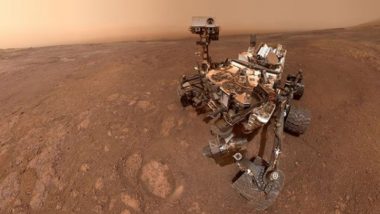Selfies are a big deal these days. Every smartphone has a camera which is then attached to the internet. With technology evolving faster, it is inevitable that our vain species would take full advantage by clicking endless photos of self, friends and of course forever favourite pets. Self-portraits have become a cultural phenomenon on the planet. Hence, robots which are exploring space are also not unknown to this trend of clicking selfies. They can be pretty vain too, taking snaps for the whole internet to see. At recent, the National Aeronautics and Space Administration’s (NASA) Curiosity rover has made its final selfie on the Vera Rubin Ridge before heading to another location on the Red Planet. Two Suns Seen in the USA and Canada Border? Fake News Doing Rounds on WhatsApp and Facebook.
NASA’s Curiosity rover has impressed the world earlier too with its selfie prowess. The Vera Rubin Ridge (named after the famous astronomer, Vera Rubin who discovered dark matter) on the red planet has been rover’s home for above a year. Throughout, it provided scientists with new samples and questions to puzzle over. On December 15, the robot drilled its 19th sample at a location on the ridge known as Rock Hall. And on January 15, the Curiosity rover used its Mars Hand Lens Imager (MAHLI) camera; the instrument is located on the end of the Curiosity’s arm. Unlike us, Curiosity favours stitching together shots to build a composite image, instead of using filters to flatter the netizens. As reported by NASA, it took a series of 57 shots and created one final product. How Does Earth Look From The Space? These Live Streaming and Time Lapse Videos From ISS Will Leave You Spellbound.
NASA Curiosity Rover's Final Selfie at Mars’ Vera Rubin Ridge
The result leaves the rover looking glamorous. You can view the ‘Rock Hall’ drill hole to the lower left of the rover. The scene is dustier than usual at this time of the year because of a regional dust storm.
Curiosity rover is now headed a bit farther south on Mars, a location that is heavy in clays. As Curiosity travels, it is doing its research along the way. Through its investigations, geologists will understand how the different rock types are found at the ride and clay-bearing unit. NASA further stated that the clay minerals in this unit might provide more clues about the ancient lakes that helped from the lower levels on the Mount Sharp.
(The above story first appeared on LatestLY on Jan 29, 2019 09:55 AM IST. For more news and updates on politics, world, sports, entertainment and lifestyle, log on to our website latestly.com).













 Quickly
Quickly











